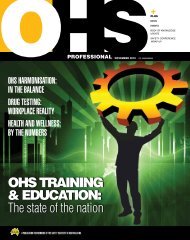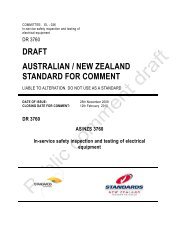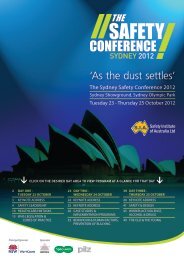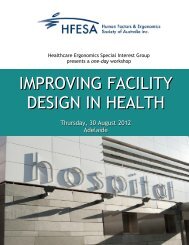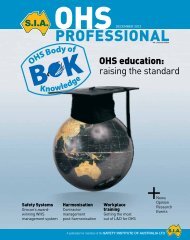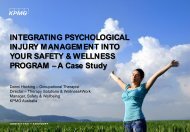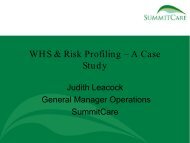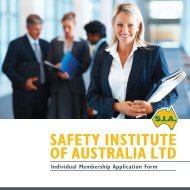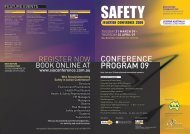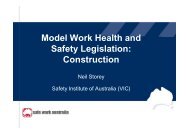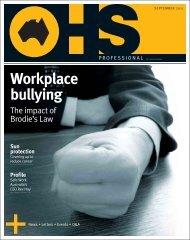Defence: overcoming its âcan Doâ culture unsW kills safety anD risk ...
Defence: overcoming its âcan Doâ culture unsW kills safety anD risk ...
Defence: overcoming its âcan Doâ culture unsW kills safety anD risk ...
You also want an ePaper? Increase the reach of your titles
YUMPU automatically turns print PDFs into web optimized ePapers that Google loves.
continued from p 17later moved to the School of Applied Science, which was <strong>its</strong>elfdisestablished, resulting in Safety’s shift to the Faculty of Scienceand Technology. It too however was shut down in 2001,landing the School of Safety Science beneath the Faculty ofScience, from which it will soon be evicted.The Safety School’s last brush with “disestablishment” wasin 2003, three years prior to Hilmer’s 2006 appointment as vicechancellor. Minutes from a meeting by the university’s AcademicBoard reveal that it planned to recommend to the thenvice-chancellor to have it “disestablished”.An independent review however reversed the decision. Priorto <strong>its</strong> change of heart, the disestablishment strategy was similarto today’s: find alternative homes for portions it wants to keep.The only part of SRSS UNSW has kept is <strong>its</strong> Risk ManagementProgram which has landed a spot at Hilmer’s old haunt,the Australian School of Business (formerly the AustralianGraduate School of Management), which he headed up prior tohis stint at Fairfax. From 2011 the Risk Management Programwill become an ASB Masters of Risk Management, while otherparts will be blended into commerce.the review rigged for <strong>safety</strong>’s failureBut for the larger portion of SRSS, death is imminent and <strong>its</strong>seed was planted in the 2008 review: <strong>its</strong> scope effectively delivereda self-fulfilling outcome in terms of <strong>its</strong> findings and subsequentrecommendations for SRSS.While research, a strength of the Faculty of Science, fell wellwithin scope, Safety’s strengths - <strong>its</strong> standard compared to otherAustralian OHS degrees; <strong>its</strong> value to the community; and contributionsto, for example, WorkCover NSW’s health efforts -did not. It strengths were not even considered in <strong>its</strong> evaluation.“gross over-reliance is placed on experiential learning beingprovided by the employer in the occupational environment, caused bylack of available teaching resources”former srss student and now general manager of sydney-based <strong>safety</strong> engineering and technical services consultancy, ross underwood“We weren’t presented well. The review said our researchwasn’t very good and suggested it should be let go,” Windersaid. “But the review was on research only and didn’t evaluateteaching programs and the value to the community.”Former SRSS student and now general manager of SydneybasedSafety Engineering and Technical Services consultancy,Ross Underwood, agrees that there will be a significant loss tothe community.The real loss, he says, is the serious dent it will have onteaching OHS management and <strong>its</strong> capacity to address a worksystem that has a reactive approach to <strong>safety</strong>.“[The system] ensures that employees at workforce entryacross every vocational stratum - from unskilled to supervisor/manager level - have virtually no OHS s<strong>kills</strong> or knowledge untilthey find out what they need to know,” Underwood told OHSProfessional.“While the research function would be an important loss, thereal concern to me is the loss of teaching,” he said.“There is a pathetic lack of OHS management knowledge ...in management systems, in industry, commerce and governmentthroughout Australia and particularly in the most populousstate NSW.“Gross over-reliance is placed on experiential learning beingprovided by the employer in the occupational environment,caused by lack of available teaching resources.”Besides this, Underwood said the SRSS has been instrumentalin developing a new matrix on the incompatibility of chemicalsubstances - “a topic with widespread ramifications acrossmany applications and with relevance to vocational and public<strong>safety</strong>,” he said.UNSW’s recently appointed Dean of Science ProfessorMerlin Crossley however has brushed aside the immediate andpractical implications of the school’s closure.Crossley has firmly rebuffed an attempt by key a figure withinthe state’s regulator WorkCover NSW to have it reconsider<strong>its</strong> decision.A WorkCover executive had in December appealed to Crossleyon the basis that SRSS had provided health and <strong>safety</strong> surveillanceeducation to authorised medical practitioners, whichthe regulator viewed as a valuable contribution to the community,while <strong>its</strong> closure would be a major loss to expertise in fireand explosion hazards Australia-wide.Signalling the university’s determination to shut theschool, Crossley replied that “a firm decision has been madeto proceed with the disestablishment, with effect from 10December 2010.”“The university has had to prioritise <strong>its</strong> limited resources,”Crossley continued, “and is determined to channel those resourcesin the Faculty of Science in research areas that it perceiveswill have even wider and deeper impact in the long term.”Crossley’s opinion is that the “university, as a whole, willremain relevant to the NSW <strong>safety</strong> professional community”and he was confident it could work with WorkCover NSW inother ways.18OHS PrOfeSSiOnaL ISSUE 3 | MARCH 2010




